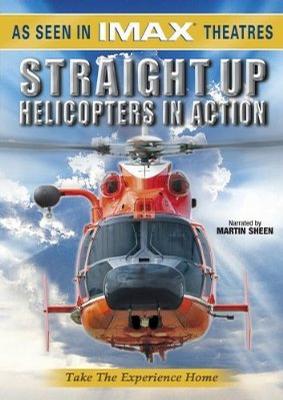Agusta 109K2: Alpine Medivac Rescue
Straight Up's exploration of vertical flight begins with a high-impact alpine rescue amid an avalanche. The dramatic opening sequence documents the dangerous work of the Rega mountain rescue team and the invaluable role of the Agusta A109K2 helicopter in saving lives and minimizing injuries.
As the camera pans over beautiful vistas of the snow-covered Swiss Alps, it cuts to a cornice, as a chunk of snow breaks free, triggering an avalanche. The tranquil scene is shattered as the avalanche thunders down the mountain slopes. With terrifying speed, it heads straight for a mother and child trapped in their car, wheels spinning on the icy road.
The mother calls for help on her cell phone, and a second call from a snowplow prompts radio dispatch. The Rega mountain rescue team already is airborne en route to the scene, the red cross painted on the helicopter's white underbelly signaling that medical help is on the way. The mother escapes, but her son is missing. Within minutes of the helicopter landing, the rescue team dig out the car, extract the trapped boy, apply first aid, and airlift him and his mother to safety.
A significant mountain hazard, avalanches are responsible for many deaths each year. Time is of the essence in avalanche rescue work. A person has a 90 percent chance of survival if found within the first 15 minutes, but one's chances of survival diminish with each passing minute. Not only do helicopters provide quick access for rescue teams, they also provide a lifeline to medical care. Flying the injured to the nearest hospital as rapidly as possible is not the only type of rescue operation; often helicopters bring the hospital to the injured, who receive treatment at the scene.
The powerful avalanche was shot in British Columbia's Selkirk Mountains under the supervision of the Canadian Avalanche Association. The CAA controls avalanche risk for the safety of heli-skiers. To capture the avalanche head-on, avalanche expert and filmmaker Steve Krochel and David Douglas developed a quarter-inch-thick steel container for the IMAX camera, which was equipped with a triggering device and a beeper so that the camera could be found once the avalanche had swept it down the mountain.
The rescue was completed in Switzerland's Bernina Pass near the Italian border. Filming the Rega rescue helicopter air-to-air sequence turned into an international excursion as Douglas chased the sunlight over Italy in one direction and in Austria in another before setting down in Switzerland. In another dramatic shot, Douglas centered the red cross in the crosshairs of the camera lens as the craft descended. To facilitate this shot, Douglas dug a hole in the snow large enough to accommodate himself and the IMAX camera. Inside the hole, 3 feet below the helicopter, he filmed its takeoff.
According to Douglas, "The helicopter is the instrument of rapid response to natural physical and social disasters around the world, alleviating human suffering on a major scale. For the individual caught beyond the limits of training or equipment, often the last chance for survival is the hope that a helicopter will get to them in time. "
The Pitcairn PCA 2, "Miss Champion"
For centuries humans dreamed of flight. The Chinese, in the 12th century, developed a toy helicopter made from a pair of slats mounted on a stick, but serious efforts had to wait until the early 20th century. Then, after the Wright brothers' historic flight at Kitty Hawk, we dreamed of flight unfettered by the limitations of runways and airports. Yet by the early 1930s we were still at the dawn of the practical rotorcraft, which promised to give form to humanity's vision.
The ten year period between 1925 and 1935 was an exciting time in aviation history, but few aircraft so caught and held the public's attention, as the Autogiro. Nicknamed the "flying windmill," this strange-looking aircraft was first successfully flown in 1923 by the Spanish inventor, Juan de la Cierva, who had been working on the development of such a craft since 1919. The Autogiro fascinated the air-minded public because of its remarkable performance and high degree of safety, attracting such leaders of American aviation as Charles Lindbergh and Amelia Earhart.
Juan de la Cierva sold the American manufacturing rights to Harold Pitcairn in 1928. Pitcairn's Autogiro boasted a more modern fuselage with better aerodynamic qualities. It also provided prospective buyers with a choice of either a 300- or 420-horsepower engine.
In the film, Harold Pitcairn's son Stephen flies "Miss Champion," a 1931 model. This Autogiro, used for promotion by the Champion Spark Plug Company, is controlled like an airplane, but is lifted with blades. Although the original rotor blades have seen 1,600 hours of flight time, they are still airworthy. With a 330-horsepower Wright R 975-E engine, the Autogiro has a cruising speed of 98 mph and a top speed of 118 mph. "Miss Champion" led a National Air Tour and made the then-risky 300- mile-long flight from Miami to Havana, Cuba. (Until then, the longest over-water flight by an Autogiro had been 25 miles in length.) Later, "Miss Champion" flew nonstop over a distance of 500 miles to Chichen Itza in the Yucatan rainforest. "Miss Champion" was retired from active service in 1932 after setting a new altitude record for rotary-wing aircraft. Climbing to a height of 21,500 feet in 1932, the Autogiro surpassed the previous record set by Amelia Earhart. Today, the Autogiro is considered to be the evolutionary "missing link" from which the practical helicopter was born.
Forty years later Stephen Pitcairn began the formidable task of collecting and restoring examples of his father's aircraft. He tracked down "Miss Champion" and in October of 1982 began the painstaking task of restoration, using the original Pitcairn factory drawings. In the spring of 1985 "Miss Champion" flew again.
The Bell 47G: A Flying Lesson
Since Pitcairn'
更多介绍......

